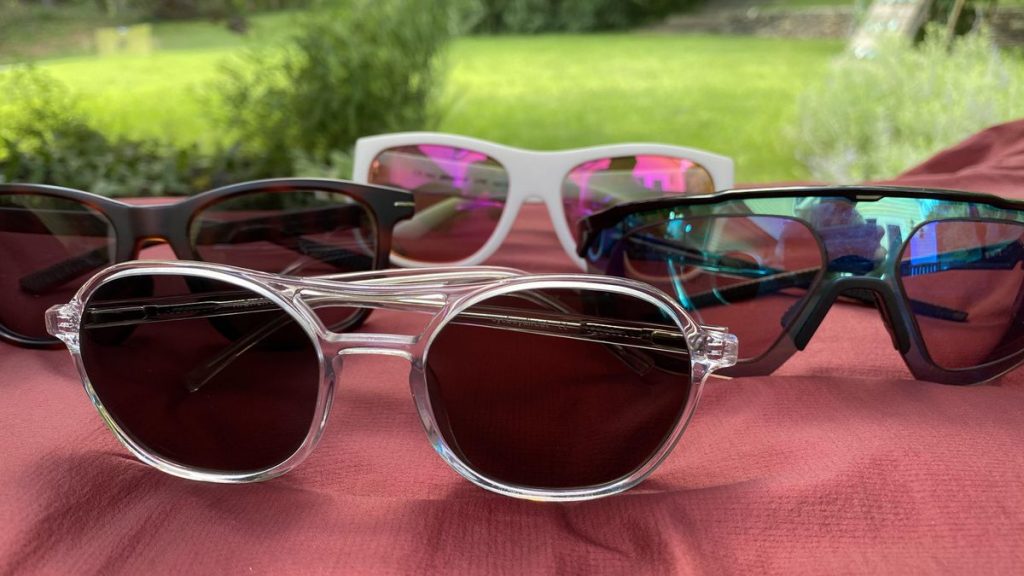
Obligatory UV Lecture
No matter where and when you intend to use your sunglasses, make sure the lenses are 100% protective against UVA and UVB rays. The phrase “UV 400” means the same thing. Your lenses must protect your eyes against light rays up to 400 nanometers in wavelength. All high-quality sunglasses from the major sport brands do. Some fashion sunglasses do not. Many cheap sunglasses do not. Some cheapies will sport a vague hang tag that reads something like: “UV protective” or “100% UV.” Is that UVA and UVB? Maybe not. If you have any doubt, investigate. Or, buy from a reputable manufacturer. All sunglasses reviewed on this site provide full UV protection.
Should You Buy Glass Lenses?
The acuity of top-notch glass lenses is why I say “Great sunglasses are better than reality.” When glass lenses are carefully ground and polished, they have the potential to deliver the crispest optics imaginable. Great glass lenses have an element of snap, a startling clarity, that other materials can approach but never surpass. Glass, however, is tricky stuff to work with. Unless it’s sliced really thin, it can create uncomfortably heavy shades. Polarizing film has to be sandwiched between layers of glass, which means each eye is looking through two layers of bonded glass. Such processes are costly. You’ll always pay a premium for glass.
While glass is great for street or fashion wear, if your lifestyle might include impact with foreign objects, glass isn’t a great idea. It’s susceptible to shattering. On the other hand, it’s much more resistant to scratching than any plastic lens, even if the plastic lens has a fancy coating.
Finally, just because sunglasses are glass doesn’t mean they’re great. In the hands of the masters of the craft like Maui Jim, Costa del Mar, or Smith, they probably are. But great sunglasses with plastic lenses easily surpass mediocre glass shades. If you want the brilliance of glass, be prepared to shell out for the thrill.
Do You Want Polycarbonate Lenses?
Plastic lenses for sunglasses come in several flavors, including polycarbonate (PC), CR-39, and some proprietary materials. Polycarbonate is the best choice for action sports. Sunglasses made for the military (e.g., those from Wiley X, Smith, and Oakley) are invariably made with polycarbonate (PC) lenses. In fact, any premium sunglasses made to withstand occupational hazards are made with polycarbonate. If there’s a chance of a pebble flying into your eyes, of your taking an endo, or (heaven forbid) a chance of fragments from bullet fire hitting your eyes, you want PC lenses. For mountain biking, river rafting, rock climbing, volleyball, baseball, even golf, you want polycarbonate lenses.
Only polycarbonate lenses stand a chance of passing both ANSI Z-87.1 tests for impact resistance. In one test, a 25mm steel ball gets fired at a lens mounted on a face form. In the other, a pointed, 1.1-pound weight is dropped on a lens, also mounted on a face form. To pass, the lenses cannot shatter AND cannot make contact with the face form. The frame has to hold the lens in place, which means that the sunglasses must be very carefully designed and constructed. Cheap shades made from PC lenses are very unlikely to pass that latter test.
As for acuity, polycarbonate can approach the optical clarity of glass, but only when in the hands of a manufacturer with outstanding quality control. Oakley and Wiley X make great shades using PC exclusively. But cheap polycarbonate sunglasses can be dreadfully, eye-strainingly bad.
The downside of PC? Mainly its susceptibility to scratching. The best lenses receive a scratch-resistant coating that works well, but it can’t turn plastic into glass. Lousy PC lenses will scratch like crazy.
Do you want CR-39 lenses?
CR-39 is a plastic lens material that’s been around for more than 60 years. Its attributes include light weight, impact resistance, and, in the hands of quality manufacturers (say, Bollé or Costa Del Mar), outstanding optical clarity. For all those reasons, clear CR-39 is by far the most common choice for everyday prescription eyeglasses. But that doesn’t mean it’s the best choice for sunglasses. How does it stack up to polycarbonate and glass? Far more impact-resistant than glass, but not as good as polycarbonate. More scratch-resistant than polycarbonate, but not as good as glass. But most importantly, CR-39 is not shatterproof, so it’s not your choice for action sports.
The scoop on alternative lens materials
Polycarbonate and CR-39 have lately been joined by two other excellent plastic lens materials: SR-91, a lens proprietary to Kaenon, and NXT, originally developed to provide strength and clarity for combat helicopter windshields. Here on earth, both perform capably in impact-resistance tests. Both are shatterproof.